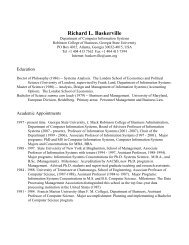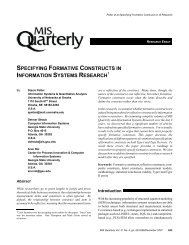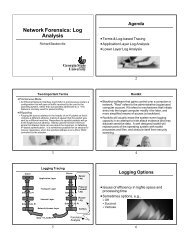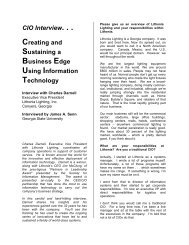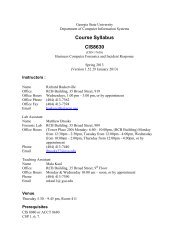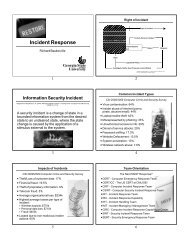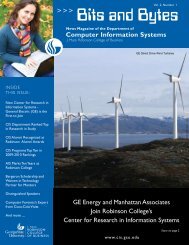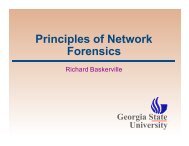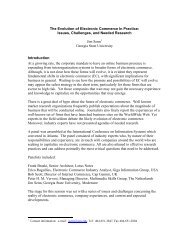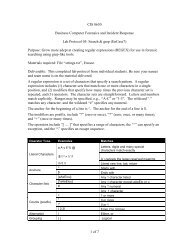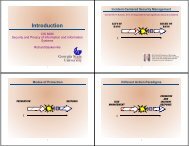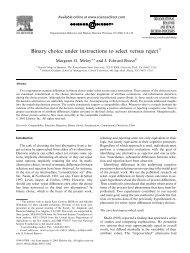The Relative Importance of Perceived Ease of Use in IS Adoption: A ...
The Relative Importance of Perceived Ease of Use in IS Adoption: A ...
The Relative Importance of Perceived Ease of Use in IS Adoption: A ...
You also want an ePaper? Increase the reach of your titles
YUMPU automatically turns print PDFs into web optimized ePapers that Google loves.
helps users achieve task-related objectives, such as task efficiency andeffectiveness.Accord<strong>in</strong>gly, the study theorizes that PEOU directly affects IT adoption onlywhen the primary task for which the IT is deployed is directly associated with<strong>in</strong>tr<strong>in</strong>sic IT characteristics, such as when the task itself is an <strong>in</strong>tegral part <strong>of</strong> an IT<strong>in</strong>terface. Extend<strong>in</strong>g this proposition to e-commerce, it was hypothesized that whena Web site is used to purchase products, PEOU would not affect IT adoptionbecause IT ease-<strong>of</strong>-use is not an <strong>in</strong>herent quality <strong>of</strong> the purchased product. On theother hand, when the Web site is used to <strong>in</strong>quire about products, PEOU shouldaffect IT adoption because the required <strong>in</strong>formation is embedded <strong>in</strong> the IT and thusits quality is directly related to IT ease-<strong>of</strong>-use. Data collected from 217 subjects <strong>in</strong>a free simulation experiment support these hypotheses. Implications for future Webdevelopment and theoretical ref<strong>in</strong>ements are discussed.Keywords: Technology acceptance model, TAM, e-commerce, perceivedease <strong>of</strong> use, PEOU, perceived usefulness, PU, IT adoption, diffusion <strong>of</strong> <strong>in</strong>novationtheory, Web development, system use, <strong>in</strong>tr<strong>in</strong>sic and extr<strong>in</strong>sic tasksI. INTRODUCTIONS<strong>in</strong>ce its <strong>in</strong>troduction, the technology acceptance model (Davis 1989; Daviset al. 1989)—TAM—has received considerable attention <strong>in</strong> the IT community.Recent studies suggest it applies also to e-commerce and to the adoption <strong>of</strong>Internet technology (Gefen 1997). In essence, TAM posits that IT adoption isaffected by prior use-related beliefs. TAM identified two such beliefs: perceivedusefulness (PU) and perceived ease <strong>of</strong> use (PEOU). <strong>The</strong> former is “the degree towhich a person believes that us<strong>in</strong>g a particular system would enhance his or her jobperformance” (Davis 1989, p. 320); while the latter is “the degree to which a personbelieves that us<strong>in</strong>g a particular system would be free <strong>of</strong> effort” (Davis 1989, p. 320).<strong>The</strong>se two beliefs create a favorable disposition or <strong>in</strong>tention toward us<strong>in</strong>g the IT thatconsequently affects its self-reported use (Davis et al. 1989).Journal <strong>of</strong> the Association for Information Systems 2
Studies that have <strong>in</strong>vestigated self-reported system usage and <strong>in</strong>tended usehave found that PU plays a significant role <strong>in</strong> determ<strong>in</strong><strong>in</strong>g such downstream effects.However, most <strong>of</strong> the studies, beg<strong>in</strong>n<strong>in</strong>g with Davis himself, have not found a directl<strong>in</strong>kage between PEOU and IT adoption. Indeed, Davis suggested that “ease <strong>of</strong> useoperates through usefulness” (p. 332), a thesis that has also been posited by laterresearch (e.g., Adams et al. 1992; Gefen 2000; Keil et at. 1995; Venkatesh andDavis 1994). Not surpris<strong>in</strong>gly, some research has questioned the overall importance<strong>of</strong> PEOU <strong>in</strong> IT adoption (e.g., Keil et al. 1995). <strong>The</strong> role <strong>of</strong> PEOU <strong>in</strong> TAM,however, rema<strong>in</strong>s controversial <strong>in</strong> that some studies show that PEOU does directlyaffect either self-reported use or <strong>in</strong>tended IT use.<strong>The</strong> objective <strong>of</strong> this study is to propose a theoretical explanation <strong>of</strong> thevary<strong>in</strong>g effects <strong>of</strong> PEOU on IT adoption by differentiat<strong>in</strong>g between tasks that are<strong>in</strong>tr<strong>in</strong>sic and tasks that are extr<strong>in</strong>sic to the IT. Tasks that are <strong>in</strong>tr<strong>in</strong>sic to the IT aretasks where the IT itself provides the primary “ends,” i.e., the product or service forwhich the IT is ultimately be<strong>in</strong>g used. Tasks that are extr<strong>in</strong>sic to the IT, on the otherhand, are those <strong>in</strong> which the IT is only the “means” to achiev<strong>in</strong>g the primary productor service, i.e., where the IT is not the central component <strong>of</strong> the process but is<strong>in</strong>strumental <strong>in</strong> achiev<strong>in</strong>g it, such as when the IT is the <strong>in</strong>terface through which oneaccomplishes a goal.Specific examples will help to make the po<strong>in</strong>t concrete. Purchas<strong>in</strong>g a bookthrough a Web site (which is itself an IT, <strong>of</strong> course) is a task extr<strong>in</strong>sic to the ITbecause the IT serves only as an <strong>in</strong>terface (collect<strong>in</strong>g book order data) to anothersystem that handles the primary purchase activities <strong>in</strong>volved (shipp<strong>in</strong>g andpayments). Conversely, us<strong>in</strong>g the same Web site to <strong>in</strong>quire about a book representsan <strong>in</strong>tr<strong>in</strong>sic IT task because the IT, itself an <strong>in</strong>tegrated application us<strong>in</strong>g both an<strong>in</strong>telligent <strong>in</strong>terface and database, provides the actual service.Based on this dist<strong>in</strong>ction, the basic proposition <strong>of</strong> this study is that PEOUshould directly <strong>in</strong>fluence IT adoption only when the task, too, is <strong>in</strong>tr<strong>in</strong>sic to the IT.In other words, it is hypothesized that PEOU will <strong>in</strong>fluence IT adoption only whenJournal <strong>of</strong> the Association for Information Systems 3
the IT itself provides the primary product or service. <strong>The</strong> data collected <strong>in</strong> this study,analyz<strong>in</strong>g potential adopter <strong>in</strong>tended use <strong>of</strong> a book-sell<strong>in</strong>g Web site for the twodist<strong>in</strong>ctly different activities <strong>of</strong> <strong>in</strong>quiry about and purchase <strong>of</strong> books, support thisproposition. <strong>The</strong> responses show that PU <strong>in</strong>fluenced adoption <strong>of</strong> the Web site forboth purchase and <strong>in</strong>quiry objectives, while PEOU <strong>in</strong>fluenced adoption <strong>of</strong> the Website only when its <strong>in</strong>tended use <strong>in</strong>volved <strong>in</strong>quiries.II. LITERATURE REVIEWTHE TECHNOLOGY ACCEPTANCE MODELTAM is one <strong>of</strong> the most widely researched models predict<strong>in</strong>g IT adoption.Davis (1989) orig<strong>in</strong>ally exam<strong>in</strong>ed an e-mail system and a file-editor used at the timeat IBM Canada and found that both PEOU and PU were significantly correlated withself-reported use <strong>of</strong> both systems. However, when the comb<strong>in</strong>ed effect <strong>of</strong> PU andPEOU on self-reported use was exam<strong>in</strong>ed us<strong>in</strong>g l<strong>in</strong>ear regression, only PUsignificantly affected use. In a follow-up study presented <strong>in</strong> the same paper, Davisasked 40 MBA students to evaluate two graphics systems with which they werepreviously unfamiliar. <strong>The</strong> subjects used workbook manuals to learn how to useboth packages before fill<strong>in</strong>g <strong>in</strong> the <strong>in</strong>struments. Analysis <strong>of</strong> the responses given bythe MBA subjects showed that for both graphic systems, only PU determ<strong>in</strong>ed their<strong>in</strong>tention to use the s<strong>of</strong>tware.In a separate study, Davis et al. (1989) asked MBA students to fill out<strong>in</strong>struments regard<strong>in</strong>g a word-processor after exam<strong>in</strong><strong>in</strong>g it for one hour and aga<strong>in</strong>after 14 weeks. Unlike the first study, Davis et al. found that PEOU, after one hour,significantly affected <strong>in</strong>tended use even when the effect <strong>of</strong> PU on <strong>in</strong>tended use wascontrolled. This significant regression relationship became <strong>in</strong>significant, however,when reexam<strong>in</strong>ed 14 weeks later with the same subjects. Unlike PEOU, PUsignificantly affected self-reported use <strong>in</strong> both time-periods.Later studies <strong>in</strong> the TAM research stream are also <strong>in</strong>consistent with respectto the effect <strong>of</strong> PEOU on downstream effects and on the mediat<strong>in</strong>g effect <strong>of</strong> PU.Journal <strong>of</strong> the Association for Information Systems 4
Table 1 lists a representative group <strong>of</strong> TAM studies to show this variation. A quickglance at the far right column <strong>in</strong>dicates the extent to which studies to date reportvariant f<strong>in</strong>d<strong>in</strong>gs about the role <strong>of</strong> PEOU <strong>in</strong> TAM. It is important to note <strong>in</strong> the context<strong>of</strong> this study that the TAM studies <strong>in</strong> the tables below dealt with an unspecified task,ma<strong>in</strong>ly ask<strong>in</strong>g subjects generally about “use” or “adoption” and without <strong>in</strong>dicat<strong>in</strong>g thespecific tasks to which the IT would be applied. <strong>The</strong> next section will discuss howthe <strong>in</strong>tr<strong>in</strong>sic and extr<strong>in</strong>sic nature <strong>of</strong> the task might help to expla<strong>in</strong> this apparentchang<strong>in</strong>g role <strong>of</strong> PEOU <strong>in</strong> TAM.THE ROLE OF PEOU: TASKS AND SYSTEM CHARACTER<strong>IS</strong>TICSAccord<strong>in</strong>g to TAM (Davis 1989; Davis et. al. 1989), PEOU and PU areimportant perceptions determ<strong>in</strong><strong>in</strong>g IT adoption. In a later study that expanded onthe orig<strong>in</strong>al TAM studies, Davis et al. (1992) expla<strong>in</strong>ed the role <strong>of</strong> these beliefs,suggest<strong>in</strong>g that user <strong>in</strong>tention to adopt a new IT is affected by both extr<strong>in</strong>sic and<strong>in</strong>tr<strong>in</strong>sic motivations. Accord<strong>in</strong>g to Davis et al., “extr<strong>in</strong>sic motivation refers to theperformance <strong>of</strong> an activity because it is perceived to be <strong>in</strong>strumental <strong>in</strong> achiev<strong>in</strong>gvalued outcomes that are dist<strong>in</strong>ct from the activity itself” (1992, p. 1112). Incontrast, “<strong>in</strong>tr<strong>in</strong>sic motivation refers to the performance <strong>of</strong> an activity for no apparentre<strong>in</strong>forcement other than the process <strong>of</strong> perform<strong>in</strong>g the activity per se” (p. 1112).Davis et al. classified enjoyment as a type <strong>of</strong> <strong>in</strong>tr<strong>in</strong>sic motivation and PU as a type<strong>of</strong> extr<strong>in</strong>sic motivation, argu<strong>in</strong>g that extr<strong>in</strong>sic motivation should have a strongerimpact on IT adoption. <strong>The</strong> reason PU is such an important antecedent <strong>of</strong> IT adoptionis that <strong>in</strong> many cases a new IT is adopted primarily because it is <strong>in</strong>strumental<strong>in</strong> achiev<strong>in</strong>g tasks that are not <strong>in</strong>herent <strong>in</strong> the use <strong>of</strong> the IT itself. PU deals with userassessments <strong>of</strong> these aspects <strong>of</strong> a new IT (Davis et al. 1992).However, the possible <strong>in</strong>tr<strong>in</strong>sic or extr<strong>in</strong>sic contributions <strong>of</strong> PEOU to ITadoption were not discussed by Davis et al. (1992). What they did posit was thatPEOU would affect IT adoption <strong>in</strong>directly through its effect on PU, because ease-<strong>of</strong>useis <strong>in</strong>strumental <strong>in</strong> mak<strong>in</strong>g a new IT more useful.Journal <strong>of</strong> the Association for Information Systems 5
StudyTable 1. Summary <strong>of</strong> TAM Studies (1989-2000)Subjects<strong>Use</strong> Measure(TAM dependentvariable)Davis 1989 (Study 1) Knowledge workers Self-reported use NoDavis 1989 (Study 2) MBA students Intended use NoDavis et al. 1989 (after 1 MBA students Intended use Yeshour)Davis et al. 1989 (after 14weeks)MBA students Self-reported use NoMathieson 1991UndergraduatestudentsIntention to use aspreadsheetMoore and Benbasat 1991 Knowledge workers PC adoption YesThompson et al. 1991 Knowledge workers PC utilization YesDavis et al. 1992 (study 1) MBA students Intentions to use a newword-processorDavis et al. 1992 (study 2) MBA students Intentions to use a newcomputer-graphicspackageDid PEOUAffect<strong>Use</strong>?NoNotexam<strong>in</strong>edNotexam<strong>in</strong>edAdams et al. 1992 (study 1) Knowledge workers Self-reported use <strong>of</strong> e-mail NoAdams et al. 1992 (study 2) Knowledge workers Self-reported use <strong>of</strong> voice NomailHendrickson et al. 1993 UndergraduatestudentsNot relevantNotmeasuredSegars and Grover 1993 Adams et al.’s (1992) Not relevantNodataSubramanian 1994 Knowledge workers Predicted adoption <strong>of</strong> Novoice mailSubramanian 1994 Knowledge workers Predicted adoption <strong>of</strong> adial-up systemNoSambamurthy and Ch<strong>in</strong>1994Venkatesh and Davis 1994UndergraduatestudentsUndergraduatestudents<strong>Use</strong> and attitude towarduse <strong>of</strong> a GDSSSelf-reported <strong>in</strong>tentions touse e-mail and gophersystemsNot directlymeasuredYesStraub 1994 Knowledge workers Self-reported use <strong>of</strong> e-mailand FAXNotreportedSzajna 1994 MBA students <strong>Adoption</strong> <strong>of</strong> s<strong>of</strong>tware NopackagesCh<strong>in</strong> and Todd 1995 Knowledge workers <strong>Perceived</strong> usefulness <strong>of</strong> e-mailNotrelevantPremkumar and Potter 1995 Knowledge workers <strong>Adoption</strong> <strong>of</strong> CASE tools NoStraub et al. 1995 (model 1) Knowledge workers Self-reported use <strong>of</strong> voice Nomail systemStraub et al. 1995 (model 2) Knowledge workers Actual use <strong>of</strong> voice mailsystemNoJournal <strong>of</strong> the Association for Information Systems 6
StudyCh<strong>in</strong> and Gopal 1995Table 1. Summary <strong>of</strong> TAM Studies (1989-2000)SubjectsUndergraduatestudents<strong>Use</strong> Measure(TAM dependentvariable)Intention to adopt brieflydescribed GSSKeil et al. 1995 Knowledge workers Self-reported use <strong>of</strong> an ES NoTaylor and Todd 1995a; Students1995bSelf-reported attitudetoward adopt<strong>in</strong>g thecomputer centerIgbaria et al. 1995 MBA students Self-reported PC usage NoHendrickson and Coll<strong>in</strong>s1996UndergraduatestudentsSelf-reported logged time<strong>of</strong> use over a four weekperiod measur<strong>in</strong>gfrequency and duration.Montazemi et al. 1996 Knowledge workers Assessment <strong>of</strong> s<strong>of</strong>twarepackagesChau 1996 (study 1)Chau 1996 (study 2)Szajna 1996 (study 1: preimplementation)Szajna 1996 (study 2: postimplementation)Adm<strong>in</strong>istrative/clericalstaffAdm<strong>in</strong>istrative/clericalstaffGraduate bus<strong>in</strong>essstudentsGraduate bus<strong>in</strong>essstudentsIntention to use a wordprocessorIntention to use aspreadsheetIntention to use an e-mailafter an hour‘s hands-ondemonstrationIntention to use an e-mailand actual usage 15weeks laterSelf-reported use <strong>of</strong> e-mailGefen and Straub 1997 Knowledge workers <strong>in</strong>airl<strong>in</strong>e <strong>in</strong>dustryStraub et al. 1997Knowledge workers <strong>in</strong> Self-reported use <strong>of</strong> e-mailairl<strong>in</strong>e <strong>in</strong>dustryGefen 1997 MBA students Intended adoption <strong>of</strong>freeware (withoutexam<strong>in</strong><strong>in</strong>g the s<strong>of</strong>tware)Did PEOUAffect<strong>Use</strong>?YesNotexam<strong>in</strong>edBettermodel fitavailablewhen thepath ismodeled.NotrelevantNoGefen and Keil 1998 Knowledge workers Self-reported use <strong>of</strong> an Noexpert system (ES)Doll at al. 1998UndergraduatestudentsNot exam<strong>in</strong>edNotexam<strong>in</strong>edFenech 1998UndergraduatestudentsSelf-reported use NotreportedRose and Straub 1999 Knowledge workers Self-reported use <strong>of</strong> YescomputersKarahanna and Straub 1999 Knowledge workers Self-reported use <strong>of</strong> e-mail NoKarahanna et al. 1999(study 1)Knowledge workers Intended use <strong>of</strong> W<strong>in</strong>dowsamong potential adoptersYesNoNoNoNoNoYesJournal <strong>of</strong> the Association for Information Systems 7
Table 1. Summary <strong>of</strong> TAM Studies (1989-2000)StudyKarahanna et al. 1999(study 2)Venkatesh 1999SubjectsKnowledge workersKnowledge workerstak<strong>in</strong>g non-work relatedtra<strong>in</strong><strong>in</strong>g <strong>in</strong> eitherlecture-based tra<strong>in</strong><strong>in</strong>gor game-based tra<strong>in</strong><strong>in</strong>g<strong>Use</strong> Measure(TAM dependentvariable)Intended use <strong>of</strong> W<strong>in</strong>dowsamong actual usersIntended use <strong>of</strong> anInternet based applicationdeal<strong>in</strong>g with a virtualworkplace system (but notrelated to the knowledgeworkers’ actual workplace)Gefen 2000 Knowledge workers Intended adoption <strong>of</strong> anew ERPDid PEOUAffect<strong>Use</strong>?NoYesNo<strong>The</strong> role <strong>of</strong> PEOU, however, is likely to be more complex than that. PEOUmeasures user assessments <strong>of</strong> ease <strong>of</strong> use and ease <strong>of</strong> learn<strong>in</strong>g. PEOU, thus,deals with user motivation that is based on the assessment <strong>of</strong> the <strong>in</strong>tr<strong>in</strong>sic aspect<strong>of</strong> us<strong>in</strong>g the IT, such as its <strong>in</strong>terface and the process <strong>in</strong>volved <strong>in</strong> us<strong>in</strong>g it. Arguably,s<strong>in</strong>ce the extr<strong>in</strong>sic aspect <strong>of</strong> the IT (captured through PU) and not its <strong>in</strong>tr<strong>in</strong>sicaspect, <strong>in</strong> many cases, is the reason a new IT is adopted, this implies that PU andnot PEOU should directly affect IT adoption. Much <strong>of</strong> the TAM-related researchseems to support this conclusion (see Table 1).Nonetheless, by the same logic, PEOU should affect IT adoption when the<strong>in</strong>tr<strong>in</strong>sic characteristics <strong>of</strong> the IT, such as its <strong>in</strong>terface clarity and navigational ease,contribute to the value <strong>of</strong> the actual outcome for which the IT is be<strong>in</strong>g used.Conceptually, this should occur when the output <strong>of</strong> the IT is <strong>in</strong>extricably bound tothe <strong>in</strong>terface itself, <strong>in</strong> which case, the PEOU <strong>of</strong> the IT should correlate directly to thevalue placed on IT outcomes.Whether the motivation to use the new IT is <strong>in</strong>tr<strong>in</strong>sic or extr<strong>in</strong>sic dependsupon the nature <strong>of</strong> the task for which the new IT is be<strong>in</strong>g employed, not upon thenature <strong>of</strong> the technology. Thus, e-mail usage can be an <strong>in</strong>tr<strong>in</strong>sic task, for example,if the objective <strong>in</strong> us<strong>in</strong>g it is simply to <strong>in</strong>form, or an extr<strong>in</strong>sic task, if the objective isJournal <strong>of</strong> the Association for Information Systems 8
specifically to improve organizational performance through better communication.Unfortunately, because the TAM studies cited <strong>in</strong> Table 1 seldom specify the nature<strong>of</strong> the task, it is difficult to assess <strong>in</strong> most cases whether the IT studied was usedfor <strong>in</strong>tr<strong>in</strong>sic or extr<strong>in</strong>sic tasks.Despite this ambiguity, partial support for the proposition above might bederived from Table 1. Exclud<strong>in</strong>g studies us<strong>in</strong>g students (Ch<strong>in</strong> and Gopal 1995;Gefen 1997; Venkatesh and Davis 1994) and non-work related sett<strong>in</strong>gs (Venkatesh1999)—where arguably the subjects did not use the IT to perform extr<strong>in</strong>sic tasks—the only cases where PEOU directly affected <strong>in</strong>tended or actual use dealt either withPC adoption (Moore and Benbasat 1991), PC utilization (Rose and Straub 1999;Thompson et al. 1991), or new users (Karahanna et al. 1999). <strong>The</strong>se studies couldbe <strong>in</strong>terpreted to support the basic proposition <strong>of</strong> the study. In the cases <strong>of</strong> PCadoption or utilization, the ease <strong>of</strong> use <strong>of</strong> the IT is both an <strong>in</strong>tr<strong>in</strong>sic characteristic <strong>of</strong>the IT and an important aspect <strong>of</strong> its extr<strong>in</strong>sic value. Also <strong>in</strong> the case <strong>of</strong> new users,ease <strong>of</strong> learn<strong>in</strong>g to use the IT (as measured through PEOU) is a central elementenabl<strong>in</strong>g users to obta<strong>in</strong> extr<strong>in</strong>sic value from the IT, i.e., to perform a work-relatedtask. F<strong>in</strong>ally, consistent with this observation, many <strong>of</strong> the TAM studies <strong>in</strong> Table 1that clearly deal with knowledge workers apply<strong>in</strong>g the IT to achieve a work-relatedtask show that PEOU did not directly affect <strong>in</strong>tended use (e.g.,Gefen 2000; Gefenand Keil 1998; Gefen and Straub 1997; Keil et al. 1995; Straub et al. 1997). 1 Thus,a sizable proportion <strong>of</strong> the studies that did f<strong>in</strong>d a direct effect <strong>of</strong> PEOU on self-1 In the case <strong>of</strong> studies on students, the reader is seldom told enough to assess whether thetask is <strong>in</strong>tr<strong>in</strong>sic or extr<strong>in</strong>sic. Karahanna et al.’s (1999) second study (deal<strong>in</strong>g with post-adoptionassessment) also deals with extr<strong>in</strong>sic tasks. Keil et al. (1995) and Gefen and Keil (1998) exam<strong>in</strong>edan expert system that was used to assist <strong>in</strong> the configuration <strong>of</strong> new IT, the primary task be<strong>in</strong>gbuild<strong>in</strong>g the actual IT for the customer. Gefen and Straub (1997) and Straub et al. (1997) dealt withe-mail systems <strong>in</strong> the airl<strong>in</strong>e <strong>in</strong>dustry that were deployed to enhance the organization’s performanceby add<strong>in</strong>g electronic communication to exist<strong>in</strong>g communication systems. <strong>The</strong> primary task here too,was not the communication, but improv<strong>in</strong>g organizational performance. Gefen (2000) dealt with theadoption <strong>of</strong> enterprise resource plann<strong>in</strong>g (ERP) systems. <strong>The</strong>se are large and complex s<strong>of</strong>twarepackages that <strong>in</strong>tegrate and manage the <strong>in</strong>formation needs <strong>of</strong> companies.Journal <strong>of</strong> the Association for Information Systems 9
eported use may deal with tasks that are <strong>in</strong>tr<strong>in</strong>sic to the IT, as implied by the basic<strong>in</strong>tr<strong>in</strong>sic-extr<strong>in</strong>sic proposition <strong>of</strong> this study. 2III. HYPOTHESES AND RESEARCH MODELTo exam<strong>in</strong>e this proposition, this study utilized a popular e-commerce sitespecializ<strong>in</strong>g <strong>in</strong> sell<strong>in</strong>g books. <strong>The</strong> grow<strong>in</strong>g importance <strong>of</strong> e-commerce (Colecchia1999; Halhead 1995; Harr<strong>in</strong>gton and Reed 1996; Rayport and Sviokla 1994, 1995)and its exponentially <strong>in</strong>creas<strong>in</strong>g economic impact (Colecchia 1999) makes the study<strong>of</strong> this effect <strong>of</strong> PEOU especially important <strong>in</strong> the context <strong>of</strong> e-commerce. 3 <strong>The</strong> use<strong>of</strong> such a site is also ideally suited to the context <strong>of</strong> this study because <strong>in</strong> a typicalWeb site users can apply the Internet to either <strong>in</strong>quire about products and servicesor to purchase them. <strong>The</strong>se two types <strong>of</strong> possible use correspond to the two types<strong>of</strong> use affect<strong>in</strong>g the role <strong>of</strong> PEOU <strong>in</strong> IT adoption, as discussed earlier.When us<strong>in</strong>g the Web site for <strong>in</strong>quiry, the outcome <strong>of</strong> us<strong>in</strong>g the IT isembedded <strong>in</strong> the IT (through its <strong>in</strong>terface and database) and is the primary task.As such, the characteristics <strong>of</strong> the IT itself should directly affect the ease <strong>of</strong> the<strong>in</strong>formation retrieval process and the presentation <strong>of</strong> results. Moreover, s<strong>in</strong>ce the<strong>in</strong>quiry task is <strong>in</strong>tr<strong>in</strong>sic to the search<strong>in</strong>g capabilities <strong>of</strong> the IT, and the entire processis performed with<strong>in</strong> the Web site <strong>in</strong>terface and database, PEOU—assess<strong>in</strong>g the<strong>in</strong>tr<strong>in</strong>sic characteristics <strong>of</strong> the IT—should <strong>in</strong>fluence user <strong>in</strong>tentions to use the IT. On2 Review<strong>in</strong>g these two constructs through a diffusion <strong>of</strong> <strong>in</strong>novation (DOI) perspective <strong>of</strong>fersadditional <strong>in</strong>sights that might expla<strong>in</strong> why PEOU affects <strong>in</strong>tended use depend<strong>in</strong>g on the type <strong>of</strong> use.Most people adopt an <strong>in</strong>novation because <strong>of</strong> its perceived outcomes (Rogers 1983, 1995). This isalso true regard<strong>in</strong>g IT adoption where most people adopt an IT because <strong>of</strong> its perceived effects onoutcomes that are extr<strong>in</strong>sic to the IT itself, such as its usefulness to perform<strong>in</strong>g work related activity(Moore 1991). Only very few people, the “<strong>in</strong>novators,” adopt an IT because <strong>of</strong> its <strong>in</strong>tr<strong>in</strong>sic value, suchas the novelty and beauty <strong>of</strong> the new technology itself (Moore 1991).3 Accord<strong>in</strong>g to the credit-card company V<strong>IS</strong>A, its clients’ Internet purchases <strong>in</strong> 1998 totaled$13 billion or approximately 1% <strong>of</strong> its total charge activity. This figure is expected to reach the $100billion mark or 11% <strong>of</strong> its total transactions by 2003, accord<strong>in</strong>g to the New York Times (12/15/1998)(www.nytimes.com/library/tech/reference/tedeschibio.html/library/tech/reference/tedeschibio.html).A more recent estimate by <strong>The</strong> Economist (2/26/2000) put these figures at $20 billion <strong>in</strong> 1999,estimated to <strong>in</strong>crease to $150 billion by 2003.Journal <strong>of</strong> the Association for Information Systems 10
F<strong>in</strong>ally, <strong>in</strong> accordance with the classic TAM, it is hypothesized that PEOU will<strong>in</strong>fluence PU because an easy-to-use IT is more useful (Davis 1989; Davis et al.1992), as shown <strong>in</strong> many <strong>of</strong> the studies <strong>in</strong> Table 1:H 3 : PEOU affects PU.<strong>The</strong> research model summariz<strong>in</strong>g these hypotheses is presented <strong>in</strong> Figure1, below. Hypothesized significant effects are displayed <strong>in</strong> solid l<strong>in</strong>e arrows;hypothesized non-effects are displayed <strong>in</strong> broken-l<strong>in</strong>e arrows.PUIntendedInquiryPEOUH 3H 2a H H 2b1aH 1bIntendedPurchaseFigure 1. Research Model and HypothesesIV. RESEARCH METHODPROCEDURE<strong>The</strong> study employed a free simulation experimental method (Fromk<strong>in</strong> andStreufert 1976) <strong>in</strong> which the researchers place subjects <strong>in</strong> a real-world situation andask them to make decisions and choices. In free simulation experiments,treatments are not preprogrammed, but are allowed to range freely and to occurnaturally as responses to the experimental tasks.To explore the hypothesized role <strong>of</strong> PEOU, 217 MBA students at a largebus<strong>in</strong>ess school <strong>in</strong> the mid-Atlantic region <strong>of</strong> the United States were asked tonavigate the Internet to a well-known Web site that specializes <strong>in</strong> books. Oncethere, they were <strong>in</strong>structed to request the textbook used <strong>in</strong> the course they weretak<strong>in</strong>g. All subjects completed the <strong>in</strong>strument <strong>in</strong> the same computer-equippedInternet-connected classroom managed by the researchers dur<strong>in</strong>g class sessions.Journal <strong>of</strong> the Association for Information Systems 12
All the PCs <strong>in</strong> the classroom had identical configurations and all were equipped withthe same browser, namely, Internet Explorer. <strong>The</strong> researcher <strong>in</strong> charge used anoperationalization manual to assure that all <strong>of</strong> the subjects were exposed to exactlythe same procedure. 4 <strong>The</strong> manual appears <strong>in</strong> Appendix A.S<strong>in</strong>ce all subjects were presented with the same <strong>in</strong>formation us<strong>in</strong>g the same<strong>in</strong>terface, the potential effect <strong>of</strong> exogenous variance due to PC configuration andbrowser type was controlled. Subjects were <strong>in</strong>structed to search for their textbookand then read about it. Subjects did not actually purchase the textbook, althoughover half <strong>of</strong> them reported that they had purchased textbooks on other occasionsthrough the Web. <strong>The</strong> objective <strong>of</strong> the task was to make sure all <strong>of</strong> the subjectswere familiar with the specific IT and that the <strong>in</strong>terface and procedure were fresh <strong>in</strong>their m<strong>in</strong>ds before fill<strong>in</strong>g <strong>in</strong> the <strong>in</strong>strument, consistent with Davis et al. (1989).After complet<strong>in</strong>g this task, subjects were asked to fill <strong>in</strong> a research <strong>in</strong>strument.<strong>The</strong>y were not rewarded for their participation <strong>in</strong> the study and were told <strong>of</strong>its objective only after all the <strong>in</strong>struments were returned. Access<strong>in</strong>g a real-worldWeb site represents the use <strong>of</strong> a “live” environment, which adds to the externalvalidity <strong>of</strong> the results (Cook and Campbell 1979) <strong>in</strong> that it embodies “critical realism”(Fromk<strong>in</strong> and Streufert 1976). External validity is also reasonably good <strong>in</strong> thiscontext <strong>in</strong> that bus<strong>in</strong>ess students serve as good surrogates for real world managers<strong>in</strong> decision mak<strong>in</strong>g contexts (Remus 1986) and are an <strong>in</strong>tegral part <strong>of</strong> the population<strong>of</strong> onl<strong>in</strong>e book buyers.<strong>The</strong> <strong>in</strong>strument gathered data on PU and PEOU via items adapted from theorig<strong>in</strong>al TAM scales proposed by Davis (1989) and by Davis et al. (1989). 5 Subjects4 All the PCs <strong>in</strong> the classroom used W<strong>in</strong>dows NT, which was set up <strong>in</strong> such a way thatstudents could not change the “C” drive, <strong>in</strong>clud<strong>in</strong>g the “Temporary Internet Files” (which is wherecookies are usually placed). Thus, the Web site s<strong>of</strong>tware could not use cookies to customize the<strong>in</strong>terface and present subjects with different <strong>in</strong>terfaces based on past activities, further <strong>in</strong>sur<strong>in</strong>g thatall the students experienced exactly the same <strong>in</strong>terface.5 <strong>The</strong> sixth item <strong>of</strong> the orig<strong>in</strong>al PU scale was dropped from the analysis because <strong>in</strong> the pretestit did not show sufficient discrim<strong>in</strong>ant validity. A closer exam<strong>in</strong>ation <strong>of</strong> this item dur<strong>in</strong>g the pretestsuggested that the term “useful” as used <strong>in</strong> the item was ambiguous <strong>in</strong> the context <strong>of</strong> this study.Journal <strong>of</strong> the Association for Information Systems 13
Table 2. List <strong>of</strong> Questionnaire ItemsConstruct Code Question Word<strong>in</strong>gIntended Purchase PUR1 I would use my credit card to purchase from ABC.PUR2 I would not hesitate to provide <strong>in</strong>formation to ABC.PUR3 I am very likely to buy books from ABC.Intended Inquiry INQ1 I would use ABC to retrieve <strong>in</strong>formation.INQ2 I would use ABC to <strong>in</strong>quire what readers th<strong>in</strong>k <strong>of</strong> abook.INQ3 I would use ABC to f<strong>in</strong>d out about the author <strong>of</strong> abook.INQ4 I would use ABC to <strong>in</strong>quire about book rat<strong>in</strong>gs.<strong>Perceived</strong> <strong>Use</strong>fulness(PU)PU1 ABC improves my performance <strong>in</strong> book search<strong>in</strong>gand buy<strong>in</strong>g.PU2 ABC enables me to search and buy books faster.PU3 ABC enhances my effectiveness <strong>in</strong> book search<strong>in</strong>gand buy<strong>in</strong>g.PU4 ABC makes it easier to search for and purchasebooks.PU5 ABC <strong>in</strong>creases my productivity <strong>in</strong> search<strong>in</strong>g andpurchas<strong>in</strong>g books.<strong>Perceived</strong> <strong>Ease</strong> <strong>of</strong> PEOU1 ABC is easy-to-use.<strong>Use</strong> (PEOU)PEOU2 It is easy to become skillful at us<strong>in</strong>g ABC.PEOU3 Learn<strong>in</strong>g to operate ABC is easy.PEOU4 ABC is flexible to <strong>in</strong>teract with.PEOU5 My <strong>in</strong>teraction with ABC is clear andunderstandable.PEOU6 It is easy to <strong>in</strong>teract with ABC.Table 3. Sample Population DemographicsDemographicsMeanAge 28Number <strong>of</strong> times used the specific Web site before this study 2.94Number <strong>of</strong> subjects who had previously purchased on the Internet 89Women / Men (some subjects did not answer) 86/ 93Journal <strong>of</strong> the Association for Information Systems 15
V. ANALYS<strong>IS</strong> AND RESULTS<strong>The</strong> data were first analyzed us<strong>in</strong>g a PCA factor analysis to establishconvergent and discrim<strong>in</strong>ant validity. <strong>The</strong> factor analysis showed four orthogonalfactors with eigenvalues above 1.0, together account<strong>in</strong>g for 77.7% <strong>of</strong> the variation,with item communality rang<strong>in</strong>g between .64 and .88. <strong>The</strong> results <strong>of</strong> the factoranalysis after a VARIMAX rotation are presented <strong>in</strong> Table 4. Load<strong>in</strong>gs above .40are <strong>in</strong> shown <strong>in</strong> boldface. Overall, the factor analysis shows a simple load<strong>in</strong>gpattern with high convergent and discrim<strong>in</strong>ant validity. All constructs (factors) thatemerged from the factor analysis showed high Cronbach ?’s, establish<strong>in</strong>g thereliability <strong>of</strong> the <strong>in</strong>strument. Intended use for purchase had a Cronbach ? <strong>of</strong> .79,<strong>in</strong>tended use for <strong>in</strong>quiry .90, PU .91, and PEOU .93. <strong>The</strong>se values are well with<strong>in</strong>the thresholds suggested by Nunnally (1967). Descriptive statistics <strong>of</strong> theconstructs are also presented <strong>in</strong> Table 4.After establish<strong>in</strong>g that items loaded appropriately on their expectedconstructs, the hypotheses were exam<strong>in</strong>ed us<strong>in</strong>g l<strong>in</strong>ear regression. <strong>The</strong> l<strong>in</strong>earregression results shown <strong>in</strong> Table 5 support all hypotheses. L<strong>in</strong>ear regressionresults show that both PEOU and PU significantly affected <strong>in</strong>tended use for <strong>in</strong>quiry(support<strong>in</strong>g H 1a and H 2a , respectively), but that only PU affected <strong>in</strong>tended use forpurchase (support<strong>in</strong>g H 2b ). <strong>The</strong> analysis also shows that PEOU significantly affectsPU (support<strong>in</strong>g H 3 ). <strong>The</strong>re was no significant effect <strong>of</strong> PEOU on <strong>in</strong>tended use forpurchase, support<strong>in</strong>g the research proposition and H 1b . Table 6 summarizes thef<strong>in</strong>d<strong>in</strong>gs.Journal <strong>of</strong> the Association for Information Systems 16
Table 4. Factor Analysis and Descriptive StatisticsItemFactor 1<strong>Perceived</strong><strong>Ease</strong> <strong>of</strong> <strong>Use</strong>Factor 2<strong>Perceived</strong><strong>Use</strong>fulnessFactor 3Intentionsto InquireFactor 4IntentiontoPurchaseItemCommunalityPEOU3 .85124 .20085 .17379 .06464 .79933PEOU2 .84960 .22347 .18567 .05579 .80935PEOU4 .81996 .30444 .12507 .06598 .78501PEOU6 .80587 .27109 .08000 .20241 .77029PEOU5 .80475 .23668 .09006 .14550 .73291PEOU1 .74433 .30439 .16028 .14091 .69222PU3 .29849 .85604 .17844 .16571 .88121PU4 .27007 .85599 .15647 .15831 .85520PU5 .24375 .83264 .09680 .11727 .77583PU2 .35230 .79699 .16897 .19378 .82541PU1 .31603 .72455 .16793 .11212 .66561INQ2 .14805 .21785 .86197 .17520 .71622INQ4 .10737 .11544 .84396 .29051 .84307INQ1 .19578 .14461 .80277 .11194 .72209INQ3 .13941 .11987 .79727 .22944 .82152PUR1 .15147 .08355 .23285 .84042 .79044PUR2 .09603 .16443 .23291 .74138 .64015PUR3 .17740 .32948 .27361 .71022 .71930Eigenvalue 8.607 2.522 1.618 1.098PercentExpla<strong>in</strong>edVariance47.8 14.0 9.0 6.1Mean (std.dev.) <strong>of</strong>construct2.08 (.80) 2.42 (1.04) 2.55 (1.10) 3.14 (1.26)Journal <strong>of</strong> the Association for Information Systems 17
Table 5. Stepwise L<strong>in</strong>ear Regression ResultsDependentF-valueVariable R 2 (p-value)IntendedPurchase.20 24.42522(
observations <strong>in</strong> TAM-related studies that PU is the primary belief affect<strong>in</strong>g <strong>in</strong>tentionsto use an IT and support the conclusion drawn by Davis et al. (1992) that extr<strong>in</strong>sicmotivation is more important than <strong>in</strong>tr<strong>in</strong>sic motivation <strong>in</strong> IT adoption.Table 6. Overall Results <strong>of</strong> Hypothesis Test<strong>in</strong>g# Hypothesis Supported?H 1a PEOU affects <strong>in</strong>tended use when a Web site is used for an Yes<strong>in</strong>quiry task.H 1b PEOU does not affect <strong>in</strong>tended use when a Web site is used for Yesa purchas<strong>in</strong>g task.H 2a PU affects <strong>in</strong>tended use when a Web site is used for an <strong>in</strong>quiry Yestask.H 2b PU affects <strong>in</strong>tended use when a Web site is used for a Yespurchas<strong>in</strong>g task.H 3 PEOU affects PU. YesIMPLICATIONSPractitioners, who might have been guided by previous TAM studies tounderestimate the importance <strong>of</strong> PEOU, should reconsider the extent to whichPEOU affects system use. PEOU is important and does <strong>in</strong>fluence <strong>in</strong>tended use, butits effects are task-dependent. Consequently, when advertis<strong>in</strong>g, market<strong>in</strong>g, orimplement<strong>in</strong>g new systems, IT providers might f<strong>in</strong>d it beneficial to advocate theease <strong>of</strong> use <strong>of</strong> the IT for given tasks rather than present it <strong>in</strong> a task-<strong>in</strong>dependentmanner.Web developers need to keep <strong>in</strong> m<strong>in</strong>d that ease-<strong>of</strong>-use will be particularlyimportant <strong>in</strong> creat<strong>in</strong>g the search eng<strong>in</strong>es that accompany their sites. <strong>The</strong>se basiceng<strong>in</strong>es and the terms that allow for advanced search need to be <strong>in</strong>tuitive and clearto potential customers. Aspects <strong>of</strong> the site that process the order and shipp<strong>in</strong>g<strong>in</strong>formation and display collected data are less sensitive <strong>in</strong> that the customer is<strong>in</strong>strumentally and extr<strong>in</strong>sically motivated.Journal <strong>of</strong> the Association for Information Systems 19
From the standpo<strong>in</strong>t <strong>of</strong> TAM research, the theoretical contribution <strong>of</strong> thepaper is to suggest an explanation for the variation <strong>in</strong> TAM studies with respect tothe l<strong>in</strong>kage between PEOU and IT adoption. If confirmed by other studies, thisf<strong>in</strong>d<strong>in</strong>g would better expla<strong>in</strong> the <strong>in</strong>ner work<strong>in</strong>gs <strong>of</strong> the socio-psychological factorsthat lead to use <strong>of</strong> an <strong>in</strong>formation system. Thus, researchers should be aware thatPEOU might be better studied <strong>in</strong> the context <strong>of</strong> a given IT applied to a given taskand base their predictions on the nature <strong>of</strong> the task(s) for which the IT is primarilyused. This redef<strong>in</strong>ition <strong>of</strong> the effects <strong>of</strong> PEOU may augment the construct validity<strong>of</strong> this belief, a desired goal <strong>in</strong> any research (Cook and Campbell 1979). Thisclarification might also expla<strong>in</strong> the ambiguous results <strong>in</strong> previous TAM studies. <strong>The</strong>other element—the task—should also be measured and assessed <strong>in</strong> all future TAMstudies.LIMITATIONS AND ADDITIONAL RESEARCHBefore discuss<strong>in</strong>g additional research questions that this study raises, somecaution is necessary <strong>in</strong> <strong>in</strong>terpret<strong>in</strong>g the results. To beg<strong>in</strong> with, the effect <strong>of</strong> PEOUon <strong>in</strong>tended <strong>in</strong>quiry is significant only at the .05 level (albeit this is the same cut<strong>of</strong>f<strong>of</strong> significance as used by Davis et al. [1992]) and the R 2 is somewhat low. Anotherissue requir<strong>in</strong>g caution is the factor analysis. <strong>The</strong> factor analysis showed, asexpected, a clean load<strong>in</strong>g pattern with the four expected factors. <strong>The</strong> expla<strong>in</strong>edvariance <strong>of</strong> the fourth factor, <strong>in</strong>tended <strong>in</strong>quiry, however, is somewhat weak, stand<strong>in</strong>gat only 6.1%. While this is <strong>in</strong> the same order <strong>of</strong> magnitude for the adoption <strong>of</strong> agraphical package as reported by Davis et al. (1992), some caution is called for andadditional research replicat<strong>in</strong>g these results is needed.Another possible limitation is that the PU and PEOU items purposefully didnot differentiate between the <strong>in</strong>quiry and purchase tasks. While design<strong>in</strong>g the study<strong>in</strong> this manner allowed for the comparison <strong>of</strong> the two tasks aga<strong>in</strong>st identical scales,it may have <strong>in</strong>troduced an element <strong>of</strong> bias <strong>in</strong>to the study. Additional researchshould exam<strong>in</strong>e this possible bias.Journal <strong>of</strong> the Association for Information Systems 20
With<strong>in</strong> these limitations, the study tentatively supports the basic researchproposition that task does matter <strong>in</strong> TAM. Extend<strong>in</strong>g this proposition a step furtherimplies some <strong>in</strong>trigu<strong>in</strong>g additional questions and <strong>in</strong>sights. <strong>The</strong> study exam<strong>in</strong>edwhen PEOU affects IT adoption, but by the same logic, it implies that the effects <strong>of</strong>PU, too, might be context-dependent. Specifically, when there is little extr<strong>in</strong>sic valueto us<strong>in</strong>g an IT, such as <strong>in</strong> computer games, PU might not affect IT adoption.Additional research is needed to exam<strong>in</strong>e this <strong>in</strong>terest<strong>in</strong>g idea, which runs counterto studies on IT adoption.Another <strong>in</strong>terest<strong>in</strong>g avenue for new research is the differentiation amongtypes <strong>of</strong> adopters. Accord<strong>in</strong>g to DOI, there are several types <strong>of</strong> adopters. Mostadopt a new IT because <strong>of</strong> its extr<strong>in</strong>sic value (Moore 1991). <strong>The</strong> first to adopt a newIT are the “<strong>in</strong>novators” (estimated at 2.5% <strong>of</strong> the population) who adopt it because<strong>of</strong> its <strong>in</strong>tr<strong>in</strong>sic value. Later, the “early adopters” adopt it because it providesstrategic advantage. Only then does the “early majority” adopt the technology forpragmatic reasons, such as return-on-<strong>in</strong>vestment (ROI). <strong>The</strong>y are followed by the“late adopters” and “conservatives,” who wait until it is very well established. Thisimplies that the importance <strong>of</strong> the <strong>in</strong>tr<strong>in</strong>sic IT characteristics, <strong>in</strong>clud<strong>in</strong>g PEOU,should be greater with <strong>in</strong>novators. <strong>The</strong> sample size applied <strong>in</strong> this study did notallow us to exam<strong>in</strong>e this additional aspect <strong>of</strong> the research proposition. Additionalresearch is needed here, too.In conclusion, TAM studies need to move <strong>in</strong>to the e-commerce space todeterm<strong>in</strong>e the extent to which traditional <strong>IS</strong> models like TAM apply to cyberspace.This study found support for a theoretical ref<strong>in</strong>ement <strong>of</strong> TAM that makes it perfectlyapplicable to bus<strong>in</strong>ess to commerce and bus<strong>in</strong>ess to bus<strong>in</strong>ess systems. However,one study does not make a research stream. <strong>The</strong>refore, for the sake <strong>of</strong> rapidly<strong>in</strong>fluenc<strong>in</strong>g practice, further studies need to be conducted well and conductedquickly.Journal <strong>of</strong> the Association for Information Systems 21
VII. REFERENCESAdams D. A, Nelson, R. R., and Todd, P. A. “<strong>Perceived</strong> <strong>Use</strong>fulness, <strong>Ease</strong> <strong>of</strong> <strong>Use</strong>and Usage <strong>of</strong> Information Technology: A Replication,” M<strong>IS</strong> Quarterly (16:2),1992, pp. 227-247.Chau, P. Y. K. “An Empirical Assessment <strong>of</strong> a Modified Technology AcceptanceModel,” Journal <strong>of</strong> Management Information Systems (13:2), 1996, pp. 185-204.Ch<strong>in</strong>, W. W., and Todd, P. A. “On the <strong>Use</strong>, <strong>Use</strong>fulness, and <strong>Ease</strong> <strong>of</strong> <strong>Use</strong> <strong>of</strong>Structural Equation Model<strong>in</strong>g <strong>in</strong> M<strong>IS</strong> Research: A Note <strong>of</strong> Caution,” M<strong>IS</strong>Quarterly (19:2), 1995, pp. 237-246.Ch<strong>in</strong>, W. W., and Gopal, A. “<strong>Adoption</strong> Intention <strong>in</strong> GSS: <strong>Relative</strong> <strong>Importance</strong> <strong>of</strong>Beliefs,” Data Base for Advances <strong>in</strong> Information Systems (26:2&3), 1995, pp.42-64.Colecchia, A. “Def<strong>in</strong><strong>in</strong>g and Measur<strong>in</strong>g Electronic Commerce,” <strong>in</strong> Proceed<strong>in</strong>gs <strong>of</strong>the Conference on the Measurement <strong>of</strong> Electronic Commerce, J. Ang (ed.),S<strong>in</strong>gapore Department <strong>of</strong> Statistics, Center for Management <strong>of</strong> Innovationand Technopreneurship, and the Infocomm Development Authority <strong>of</strong>S<strong>in</strong>gapore, S<strong>in</strong>gapore, December 1999, pp. 1-15.Cook, T. D., and Campbell, D. T. Quasi-Experimentation, Design and AnalysisIssues for Field Sett<strong>in</strong>gs, Boston: Houghton Miffl<strong>in</strong>, 1979.Davis, F. D. “<strong>Perceived</strong> <strong>Use</strong>fulness, <strong>Perceived</strong> <strong>Ease</strong> <strong>of</strong> <strong>Use</strong> and <strong>Use</strong>r Acceptance<strong>of</strong> Information Technology,” M<strong>IS</strong> Quarterly (13:3), 1989, pp. 319-339.Davis, F. D., Bagozzi, R. P., and Warshaw, P. R. “Extr<strong>in</strong>sic and Intr<strong>in</strong>sic Motivationto <strong>Use</strong> Computers <strong>in</strong> the Workplace,” Journal <strong>of</strong> Applied Social Psychology(22:14), 1992, pp. 1111-1132.Davis, F. D., Bagozzi, R. P., and Warshaw, P. R. “<strong>Use</strong>r Acceptance <strong>of</strong> ComputerTechnology: A Comparison <strong>of</strong> Two <strong>The</strong>oretical Models,” ManagementScience (35:8), 1989, pp. 982-1002.Doll, W. J., Hendrickson, A., and Deng, X. “Us<strong>in</strong>g Davis’s <strong>Perceived</strong> <strong>Use</strong>fulnessand <strong>Ease</strong>-<strong>of</strong>-<strong>Use</strong> Instrument for Decision Mak<strong>in</strong>g: A Confirmatory and MultigroupInvariance Analysis,” Decision Sciences (29:4), 1998, pp. 839-869.Fenech, T. “Us<strong>in</strong>g <strong>Perceived</strong> <strong>Ease</strong> <strong>of</strong> <strong>Use</strong> and <strong>Perceived</strong> <strong>Use</strong>fulness to PredictAcceptance <strong>of</strong> the World Wide Web,” Computer Networks and <strong>IS</strong>DNSystems (30), 1998, pp. 629-630.Fromk<strong>in</strong>, H. L., and Streufert, S. “Laboratory Experimentation,” <strong>in</strong> Handbook <strong>of</strong>Industrial and Organizational Psychology, Chicago IL: Rand McNallyPublish<strong>in</strong>g Company, Inc., 1976.Gefen, D. Build<strong>in</strong>g <strong>Use</strong>rs' Trust <strong>in</strong> Freeware Providers and the Effects <strong>of</strong> this Truston <strong>Use</strong>rs’ Perceptions <strong>of</strong> <strong>Use</strong>fulness, <strong>Ease</strong> <strong>of</strong> <strong>Use</strong> and Intended <strong>Use</strong>, Ph.D.Dissertation, Computer Information Systems Department, Georgia StateUniversity, Atlanta, Georgia, 1997.Journal <strong>of</strong> the Association for Information Systems 22
Gefen, D. “Lessons Learnt from the Successful <strong>Adoption</strong> <strong>of</strong> an ERP: <strong>The</strong> CentralRole <strong>of</strong> Trust,” <strong>in</strong> Recent Developments and Applications <strong>in</strong> Decision Mak<strong>in</strong>g,S. Zanakis, G. Doukidis, and C. Zopounidis (eds.), Norwood, MA: KluwerAcademic, 2000 (forthcom<strong>in</strong>g).Gefen, D., and Keil, M. “Developer Trust-Build<strong>in</strong>g Behavior and <strong>Use</strong>r Perceptions<strong>of</strong> <strong>Perceived</strong> <strong>Use</strong>fulness: A Social-Exchange Perspective,” Data Base forAdvances <strong>in</strong> Information Systems (29:2), 1998, pp. 35-49.Gefen, D., and Straub, D. W. “Gender Differences <strong>in</strong> Perception and <strong>Adoption</strong> <strong>of</strong>E-Mail: An Extension to the Technology Acceptance Model,” M<strong>IS</strong> Quarterly(21:4), 1997, pp. 389-400.Halhead, R. “Break<strong>in</strong>g Down the Barriers to Free Information Exchange,” LogisticsInformation Management (8:1), 1995, pp. 34-37.Harr<strong>in</strong>gton, L., and Reed, G. “Electronic Commerce (F<strong>in</strong>ally) Comes <strong>of</strong> Age,”McK<strong>in</strong>sey Quarterly (2), 1996, pp. 68-77.Hendrickson, A. R., Massey, P. D., and Cronan, T. P. “On the Test-RetestReliability <strong>of</strong> <strong>Perceived</strong> <strong>Use</strong>fulness and <strong>Perceived</strong> <strong>Ease</strong> <strong>of</strong> <strong>Use</strong>,” M<strong>IS</strong>Quarterly (17:2), 1993, pp. 227-230.Hendrickson, A. R., and Coll<strong>in</strong>s, M. R. “An Assessment <strong>of</strong> Structure and Causation<strong>of</strong> <strong>IS</strong> Usage,” Data Base for Advances <strong>in</strong> Information Systems (27:2), 1996,pp. 61-67.Igbaria, M., Guimaraes, T., and Gordon, G. B. “Test<strong>in</strong>g the Determ<strong>in</strong>ants <strong>of</strong>Microcomputer Usage Via a Structural Equation Model,” Journal <strong>of</strong> ManagementInformation Systems (11:4), 1995, pp. 87-114.Karahanna, E., and Straub, D. W. “<strong>The</strong> Psychological Orig<strong>in</strong>s <strong>of</strong> <strong>Perceived</strong> <strong>Use</strong>fulnessand <strong>Perceived</strong> <strong>Ease</strong>-<strong>of</strong>-<strong>Use</strong>,” Information & Management (35), 1999,pp. 237-250.Karahanna, E., Straub, D. W., and Chervany, N. L. “Information Technology<strong>Adoption</strong> Across Time: A Cross-Sectional Comparison <strong>of</strong> Pre-<strong>Adoption</strong> andPost-<strong>Adoption</strong> Beliefs,” M<strong>IS</strong> Quarterly (23:2), 1999, pp. 183-213.Keil, M., Beranek, P. M., and Konsynski, B. R. “<strong>Use</strong>fulness and <strong>Ease</strong> <strong>of</strong> <strong>Use</strong>: FieldStudy Evidence Regard<strong>in</strong>g Task Considerations,” Decision Support Systems(13), 1995, pp. 75-91.Mathieson, K. “Predict<strong>in</strong>g <strong>Use</strong>r Intentions: Compar<strong>in</strong>g the Technology AcceptanceModel with the <strong>The</strong>ory <strong>of</strong> Planned Behavior,” Information Systems Research(2:3), 1991, pp. 173-191.Montazemi, A. R., Cameron, D. A., and Gupta, K. M. “An Empirical Study <strong>of</strong>Factors Affect<strong>in</strong>g Package Selection,” Journal <strong>of</strong> Management InformationSystems (13:1), 1996, pp. 89-105.Moore, G. A. Cross<strong>in</strong>g the Chasm, New York: Harper Bus<strong>in</strong>ess, 1991.Moore, G. C., and Benbasat, I. “Development <strong>of</strong> an Instrument to Measure thePerceptions <strong>of</strong> Adopt<strong>in</strong>g an Information Technology Innovation,” InformationSystems Research (2:3), 1991, pp. 192-222.Nunnally, J. C. Psychometric <strong>The</strong>ory, New York: McGraw-Hill, 1967.Journal <strong>of</strong> the Association for Information Systems 23
Premkumar, G., and Potter, M. “<strong>Adoption</strong> <strong>of</strong> Computer Aided S<strong>of</strong>tware Eng<strong>in</strong>eer<strong>in</strong>g(CASE) Technology: An Innovation <strong>Adoption</strong> Perspective,” Data Base forAdvances <strong>in</strong> Information Systems (26:2&3), 1995, pp. 105-123.Rayport, J. F., and Sviokla, J. J. “Exploit<strong>in</strong>g the Virtual Value Cha<strong>in</strong>,” HarvardBus<strong>in</strong>ess Review (73:6), 1995, pp. 75-85.Rayport, J. F., and Sviokla, J. J. “Manag<strong>in</strong>g <strong>in</strong> the Marketspace,” Harvard Bus<strong>in</strong>essReview (72:6), 1994, pp. 141-150.Remus, W. “Graduate Students as Surrogates for Managers <strong>in</strong> Experiments onBus<strong>in</strong>ess Decision Mak<strong>in</strong>g,” Journal <strong>of</strong> Bus<strong>in</strong>ess Research (14:1), 1986, pp.19-25.Rogers, E. M. Diffusion <strong>of</strong> Innovations (3 rd ed.), New York: <strong>The</strong> Free Press, 1983.Rogers, E. M. Diffusion <strong>of</strong> Innovations (4 th ed.), New York: <strong>The</strong> Free Press. 1995.Rose, G., and Straub, D. W. “Predict<strong>in</strong>g General IT <strong>Use</strong>: A Study <strong>in</strong> ArabDevelop<strong>in</strong>g Nations,” Journal <strong>of</strong> Global Information Management (6:3), 1999,pp. 39-46.Sambamurthy, V. , and Ch<strong>in</strong>, W. W. “<strong>The</strong> Effects <strong>of</strong> Group Attitudes TowardsAlternative GDSS Decisions on the Decision-Mak<strong>in</strong>g Performance <strong>of</strong>Computer-Supported Groups,” Decision Sciences (25:2), 1994, pp. 863-874.Segars, A. H., and Grover, V. “Re-Exam<strong>in</strong><strong>in</strong>g <strong>Perceived</strong> <strong>Ease</strong> <strong>of</strong> <strong>Use</strong> and<strong>Use</strong>fulness: A Confirmatory Factor Analysis,” M<strong>IS</strong> Quarterly (17:4), 1993, pp.517-525.Straub, D. W. “<strong>The</strong> Effect <strong>of</strong> Culture on IT Diffusion: E-Mail and FAX <strong>in</strong> Japan andthe U.S.,” Information Systems Research (5:1), 1994, pp. 23-47.Straub, D. W., Keil, M., and Brenner, W. “Test<strong>in</strong>g the Technology AcceptanceModel Across Cultures: A Three Country Study,” Information and Management(33), 1997, pp. 1-11.Straub, D. W., Limayem, M., and Karahanna, E. “Measur<strong>in</strong>g System Usage:Implications for <strong>IS</strong> <strong>The</strong>ory Test<strong>in</strong>g,” Management Science (41:8), 1995, pp.1328-1342.Subramanian, G. H. “A Replication <strong>of</strong> <strong>Perceived</strong> <strong>Use</strong>fulness and <strong>Perceived</strong> <strong>Ease</strong><strong>of</strong> <strong>Use</strong> Measurement,” Decision Sciences (25:5/6), 1994, pp. 863-874.Szajna, B. “Empirical Evaluation <strong>of</strong> the Revised Technology Acceptance Model,”Management Science (42:1), 1996, pp. 85-92Szajna, B. “S<strong>of</strong>tware Evaluation and Choice: Predictive Validation <strong>of</strong> the TechnologyAcceptance Instrument,” M<strong>IS</strong> Quarterly (18:3), 1994, pp. 319-324.Taylor, S., and Todd, P. A. “Assess<strong>in</strong>g IT Usage: <strong>The</strong> Role <strong>of</strong> Prior Experience,”M<strong>IS</strong> Quarterly (19:4), 1995a, pp. 561-570.Taylor, S., and Todd, P. A. “Understand<strong>in</strong>g Information Technology Usage: A Test<strong>of</strong> Compet<strong>in</strong>g Models,” Information Systems Research (6:2), 1995b, pp. 144-176.Thompson, R. L., Higg<strong>in</strong>s, C. A., and Howell, J. M. “Personal Comput<strong>in</strong>g: Towarda Conceptual Model <strong>of</strong> Utilization,” M<strong>IS</strong> Quarterly (15:1), 1991, pp. 125-142.Journal <strong>of</strong> the Association for Information Systems 24
Venkatesh, V. “Creation <strong>of</strong> Favorable <strong>Use</strong>r Perceptions: Explor<strong>in</strong>g the Role <strong>of</strong>Intr<strong>in</strong>sic Motivation,” M<strong>IS</strong> Quarterly (23:2), 1999, pp. 239-260.Venkatesh, V., and Davis, F. D. “Model<strong>in</strong>g the Determ<strong>in</strong>ants <strong>of</strong> <strong>Perceived</strong> <strong>Ease</strong> <strong>of</strong><strong>Use</strong>,” <strong>in</strong> Proceed<strong>in</strong>gs <strong>of</strong> the Fifteenth International Conference on InformationSystems, J. I. DeGross, S. L. Huff, and M. C. Munro (eds.), Vancouver,British Columbia, 1994, pp. 213-227.VIII. ABOUT THE AUTHORSDavid Gefen is an assistant pr<strong>of</strong>essor <strong>of</strong> M<strong>IS</strong> at Drexel University, where heteaches Strategic Management <strong>of</strong> IT, Database Analysis and Design, and VisualBasic at the MBA level. He received his Ph.D. degree <strong>in</strong> C<strong>IS</strong> from Georgia StateUniversity and a Master <strong>of</strong> Sciences from Tel-Aviv University. David has conductedextensive research on issues relat<strong>in</strong>g to the adoption, implementation and use <strong>of</strong>advanced computer technologies. His wide <strong>in</strong>terests <strong>in</strong> IT adoption stem from his12 years <strong>of</strong> experience <strong>in</strong> develop<strong>in</strong>g and manag<strong>in</strong>g large <strong>in</strong>formation systems,<strong>in</strong>clud<strong>in</strong>g the ongo<strong>in</strong>g management <strong>of</strong> a large state-<strong>of</strong>-the-art logistics system. Hisresearch specialization is <strong>in</strong> IT adoption, the Internet, culture and gender effects,s<strong>of</strong>tware ma<strong>in</strong>tenance and e-trust. His current research <strong>in</strong>terests focus on psychologicaland relational processes <strong>in</strong>volved <strong>in</strong> the successful implementation <strong>of</strong>technological <strong>in</strong>novations. His research f<strong>in</strong>d<strong>in</strong>gs have been published or are forthcom<strong>in</strong>g<strong>in</strong> lead<strong>in</strong>g academic and pr<strong>of</strong>essional journals, <strong>in</strong>clud<strong>in</strong>g the M<strong>IS</strong> Quarterly,Data Base for Advances <strong>in</strong> Information Systems, Omega: <strong>The</strong> International Journal<strong>of</strong> Management Science, and Journal <strong>of</strong> Information Technology <strong>The</strong>ory & Application.Dr. Gefen is also the author <strong>of</strong> several encyclopedia articles on IT adoption andIT security, and a book chapter on trust and ERP adoption. Dr. Gefen is a SpecialDepartmental Editor for the Data Base for Advances <strong>in</strong> Information Systems.Detmar Straub is the J. Mack Rob<strong>in</strong>son Dist<strong>in</strong>guished Pr<strong>of</strong>essor <strong>of</strong> InformationSystems <strong>in</strong> the Computer Information Systems Department and director <strong>of</strong> thedoctoral program at Georgia State University. His areas <strong>of</strong> specialization <strong>in</strong>cludetechnological <strong>in</strong>novation, computer security, IT outsourc<strong>in</strong>g and systems <strong>in</strong>tegration,<strong>in</strong>ternational IT studies, and e-commerce. He has had over 70 papers publishedor accepted <strong>in</strong> journals such as Journal <strong>of</strong> M<strong>IS</strong>, Management Science, M<strong>IS</strong>Quarterly, Information Systems Research, Organization Science, Communications<strong>of</strong> the ACM, Communications <strong>of</strong> the A<strong>IS</strong>, Information & Management, SloanManagement Review, and Academy <strong>of</strong> Management Executive. He is former coeditor<strong>of</strong> the oldest IT journal, the Data Base for Advances <strong>in</strong> Information Systemsand a former AE for the M<strong>IS</strong> Quarterly. He is currently an associate editor forInformation Systems Research and for Management Science. Detmar has consultedwidely <strong>in</strong> <strong>in</strong>dustry <strong>in</strong> the computer security area as well as <strong>in</strong> the area <strong>of</strong> technological<strong>in</strong>novation. A 1995 study ranked Detmar first among the most prolific ITresearchers for the years 1990-1994.Journal <strong>of</strong> the Association for Information Systems 25
Appendix AResearch Operationalization Manual1. <strong>The</strong> data are to be collected from MBA students <strong>in</strong> the Matheson Internetconnectedclassroom dur<strong>in</strong>g regular class sessions.2. Expla<strong>in</strong> to the class that we are conduct<strong>in</strong>g research on Internet use andwould appreciate if they could spend about five m<strong>in</strong>utes help<strong>in</strong>g us bynavigat<strong>in</strong>g to a certa<strong>in</strong> Web site, exam<strong>in</strong><strong>in</strong>g it, and complet<strong>in</strong>g an <strong>in</strong>strument.Make sure to mention that this is voluntary.3. Next, tell the students that they can obta<strong>in</strong> a detailed description <strong>of</strong> the studyand results so far by contact<strong>in</strong>g the lead researcher. Write the e-mailaddress on the whiteboard.4. Instruct the class to log <strong>in</strong> to the network and help any student <strong>in</strong> the unlikelyevent that a student might require help (the user IDs and passwords are keptat the Instructor Station).5. While the students are logg<strong>in</strong>g <strong>in</strong>, give out the <strong>in</strong>strument.6. Next, tell the class to go to the Web site <strong>in</strong> the <strong>in</strong>strument. Once there, askthe students to search for the textbook, read about it, <strong>in</strong>spect its price, andgo through the process <strong>of</strong> order<strong>in</strong>g it (but to stop before actually pay<strong>in</strong>g forit).7. Walk up and down the aisle just to make sure none <strong>of</strong> the students requireshelp.8. After collect<strong>in</strong>g the <strong>in</strong>struments, thank the students and rem<strong>in</strong>d them that adetailed description <strong>of</strong> the study can be obta<strong>in</strong>ed by e-mail<strong>in</strong>g the leadresearcher.Journal <strong>of</strong> the Association for Information Systems 26
Instructions:Appendix BQuestionnaire <strong>Use</strong>dAs part <strong>of</strong> an ongo<strong>in</strong>g study on Internet use, we would be grateful if you coulddevote 10 m<strong>in</strong>utes to complet<strong>in</strong>g this <strong>in</strong>strument.1. Please logon to the Internet and access WWW.ABC.COM.2. <strong>Use</strong> the Web site to search for the textbook <strong>of</strong> this course.3. <strong>The</strong>n, please fill <strong>in</strong> the <strong>in</strong>strument.Thank youDr. XPlease circle the appropriate category:Gender M FAge 15-19, 20-24, 25-29, 30-34, 35-39, 40-44, 50-54, 55-59,group 60-64, 65-69 above 70Have you ever bought products on the World Wide Web Yes NoHow many times have you used ABC.com?Journal <strong>of</strong> the Association for Information Systems 27
Please <strong>in</strong>dicate your agreement with the next set <strong>of</strong> statements us<strong>in</strong>g thefollow<strong>in</strong>g rat<strong>in</strong>g scale:1 2 3 4 5 6 7StronglyAgreeAgree SomewhatAgreeNeutral SomewhatDisagreeDisagree StronglyDisagreeItemCodeAssess<strong>in</strong>g the Web site1 ABC.com is easy-to-use 1 2 3 4 5 6 72 It is easy to become skillful at us<strong>in</strong>g ABC.com 1 2 3 4 5 6 73 Learn<strong>in</strong>g to operate ABC.com is easy 1 2 3 4 5 6 74 ABC.com is flexible to <strong>in</strong>teract with 1 2 3 4 5 6 75 My <strong>in</strong>teraction with ABC.com is clear and 1 2 3 4 5 6 7understandable6 It is easy to <strong>in</strong>teract with ABC.com 1 2 3 4 5 6 77 ABC.com is useful for search<strong>in</strong>g and buy<strong>in</strong>g books 1 2 3 4 5 6 78 ABC.com improves my performance <strong>in</strong> book 1 2 3 4 5 6 7search<strong>in</strong>g and buy<strong>in</strong>g9 ABC.com enables me to search and buy books 1 2 3 4 5 6 7faster10 ABC.com enhances my effectiveness <strong>in</strong> book 1 2 3 4 5 6 7search<strong>in</strong>g and buy<strong>in</strong>g11 ABC.com makes it easier to search for and 1 2 3 4 5 6 7purchase books12 ABC.com <strong>in</strong>creases my productivity <strong>in</strong> search<strong>in</strong>g 1 2 3 4 5 6 7and purchas<strong>in</strong>g booksUs<strong>in</strong>g the Web Site1 I would use ABC.com to retrieve <strong>in</strong>formation 1 2 3 4 5 6 72 I would use ABC.com to <strong>in</strong>quire what readers th<strong>in</strong>k 1 2 3 4 5 6 7<strong>of</strong> a book3 I would use ABC.com to f<strong>in</strong>d out about the author 1 2 3 4 5 6 7<strong>of</strong> a book4 I would use ABC.com to <strong>in</strong>quire about book 1 2 3 4 5 6 7rat<strong>in</strong>gs5 I would use my credit card to purchase from 1 2 3 4 5 6 7ABC.com6 I would not hesitate to provide <strong>in</strong>formation about 1 2 3 4 5 6 7my habits to ABC.com7 I am very likely to buy books from ABC.com 1 2 3 4 5 6 7Journal <strong>of</strong> the Association for Information Systems 28
Copyright © 2000, by the Association for Information Systems. Permission to make digital or hard copies <strong>of</strong> allor part <strong>of</strong> this work for personal or classroom use is granted without fee provided that copies are not made ordistributed for pr<strong>of</strong>it or commercial advantage and that copies bear this notice and full citation on the first page.Copyright for components <strong>of</strong> this work owned by others than the Association for Information Systems must behonored. Abstract<strong>in</strong>g with credit is permitted. To copy otherwise, to republish, to post on servers, or toredistribute to lists requires prior specific permission and/or fee. Request permission to publish from: A<strong>IS</strong>Adm<strong>in</strong>istrative Office, PO Box 2712 Atlanta, GA, 30301-2712 Attn: Repr<strong>in</strong>ts or via e-mail from ais@gsu.edu.EDITORPhillip E<strong>in</strong>-DorTel Aviv UniversityA<strong>IS</strong> SENIOR EDITORIAL BOARDHenry C. Lucas. Jr.Editor-<strong>in</strong>-ChiefNew York UniversityEdward A. StohrEditor-at-LargeNew York UniversityPaul GrayEditor, CA<strong>IS</strong>Claremont Graduate UniversityBlake IvesEditor, Electronic PublicationsLouisiana State UniversityPhillip E<strong>in</strong>-DorEditor, JA<strong>IS</strong>Tel-Aviv UniversityReagan RamsowerEditor, <strong>IS</strong>World NetBaylor UniversityJA<strong>IS</strong> ADV<strong>IS</strong>ORY BOARDIzak BenbasatUniversity <strong>of</strong> BritishColumbia, CanadaRobert GalliersUniversity <strong>of</strong> Warwick, UKEdgar SibleyGeorge Mason University,USANiels Bjørn-AndersenCopenhagen Bus<strong>in</strong>ess School,DenmarkSirkka JarvenpaaUniversity <strong>of</strong> Texas at Aust<strong>in</strong>,USARon WeberUniversity <strong>of</strong> Queensland,AustraliaGerard<strong>in</strong>e DeSanctisDuke University, USAJohn L. K<strong>in</strong>gUniversity <strong>of</strong> Michigan,USAVladimir ZwassFairleigh-Dick<strong>in</strong>sonUniversity, USA
JA<strong>IS</strong> EDITORIAL BOARDPaul AlparPhillipps University,GermanyRoger ClarkeAustralian NationalUniversity, AustraliaJohn HendersonBoston University, USAMagid IgbariaTel-Aviv University, IsraelJulie KendallRutgers University, USAStuart MadnickMassachusetts Institute <strong>of</strong>Technology, USAMike NewmanUniversity <strong>of</strong> Manchester,UKChrist<strong>in</strong>a SohNanyang TechnologicalUniversity, S<strong>in</strong>gaporeRick WatsonUniversity <strong>of</strong> Georgia, USARichard J. Boland Jr.Case Western ReserveUniversity, USAJoyce ElamFlorida InternationalUniversity, USARudy HirschheimUniversity <strong>of</strong> Houston, USAMathias JarkeUniversity <strong>of</strong> Aachen,GermanyRob Kl<strong>in</strong>gUniversity <strong>of</strong> Indiana, USARyutaro ManabeByunkyo University, JapanOjelanki K. NgwenyamaVirg<strong>in</strong>ia CommonwealthUniversity, USAKar Tan TamHong Kong University <strong>of</strong>Science and Technology,Hong KongPeter WeillMelbourne Bus<strong>in</strong>ess School,AustraliaClaudio CiborraUniversity <strong>of</strong> Bologna, ItalyHenrique FreitasUniversidade Federal doRio Grande do Sul, BrazilSid HuffWestern Ontario University,CanadaRob KauffmanUniversity <strong>of</strong> M<strong>in</strong>nesota,USAClaudia LoebbeckeUniversity <strong>of</strong> Cologne,GermanyTridas MukhopadhyayCarnegie-Mellon University,USAMarkku SaaksjarviHels<strong>in</strong>ki School <strong>of</strong>Economics and Bus<strong>in</strong>essAdm<strong>in</strong>istration, F<strong>in</strong>landAlex Tuzihl<strong>in</strong>New York University, USALeslie WillcocksOxford University, UKADMIN<strong>IS</strong>TRATIVE PERSONNELEph McLeanA<strong>IS</strong>, Executive DirectorGeorgia State UniversityJennifer DavisSubscriptions ManagerGeorgia State UniversityReagan RamsowerPublisher, JA<strong>IS</strong>Baylor University



